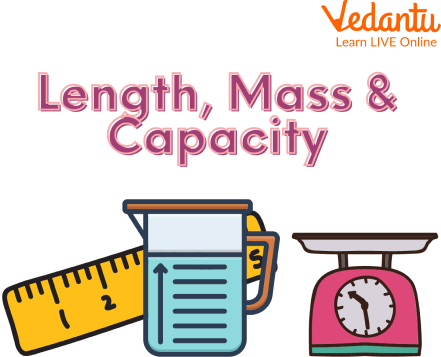




A Brief Explanation of Measures of Length Mass and Capacity
In mathematics, a unit is a standard quantity of measurement of length, mass and capacity. A unit of measurement is a definite magnitude of some physical property that is used as a standard for measurement. The word measure is used to describe the quantity of something. Measurement is a process of determining the dimensions and properties of an object or space. The International System of Units (SI) defines seven base units from which all other SI units are derived. In this section, we will discuss more metric units of length, mass and capacity. Let's begin with the topic.

Metric units of length, mass and capacity
What is Measurement?
The word “measurement” is used in mathematics to describe the process of assigning a number to a variable. Measurement can be an abstract concept or it can be as simple as counting. When we measure something, we are assigning numbers to that thing and this allows us to quantify it and compare it with other things. Measurement is an important part of mathematics and has been used for centuries. It is also closely related to geometry, which deals with lengths and distances.
Measurement is an assignment of numbers to a magnitude or distance. A measurement can be classified as either a physical measurement or a mathematical measurement. Physical measurements are taken with the help of instruments such as rulers, thermometers, and scales. Mathematical measurements are taken by calculations on numbers. We have learned about what measurement is, now let's move further to other topics.
Define Length, Mass and Capacity
The term Length, in mathematics, refers to the distance between two points, or the measure of a line segment. This measurement is usually given in the form of a number. This number can be measured in either centimetres or inches. It can also be measured by using a ruler and measuring from point A to point B. SI unit of length is m(metre).
Mass is a measure of how much matter an object contains. It is measured in kilograms. Mass can be thought of as the amount of matter in an object, but it is the amount of matter per unit volume. The SI unit for mass is the kilogram (kg).
The capacity of a container is its volume or the amount of space it has. The term capacity is used for measuring the volume of a liquid. The amount of liquid that any container can hold is called its capacity. A fluid ounce is the smallest unit of measuring capacity and the gallon is the largest unit.
Length, Weight, Capacity Chart
Here the length, weight, and capacity chart have been described, which are as follows:
Solved Examples of Measures of Length, Mass and Capacity
Here examples related to metric units of length, mass and capacity, have been described, which are as follows;
Example- Convert 0.725 Kilometres to Metres.
Ans: Given us, 0.725 Kilometres
We know that 1 kilometre = 1000 metre
So, 0.725 Kilometres=
= 725 metre
Therefore 0.725 Kilometres equals 725 metres.
Example- Convert 52 litres to cl.
Ans: Given us, 52 litres
We know that 1 L = 100 cL
So, 52 litres =
= 5200 cL
Therefore 52 litres equals 5200 cL.
Example- Convert 58.26 kg to gms.
Ans: Given us, 58.26 kg
We know that 1 kg = 1000 gm
So, 58.26 kg =
= 58260 gm
Therefore 58.26 kg equals 58260 gm.
Practice Problems
Here are some practice problems related to metric units of length mass and capacity, which are as follows;
Q1. Convert 1.45 kilometres to metres.
Ans. 1450 metres.
Q2. Convert 6.14 litres to cl.
Ans. 614 cl.
Q3. Convert 18.9 kg. to gms.
Ans. 18900 gms.
Q4. Convert 7 cm to m.
Ans. 0.07 m.
Q5. Convert 845 gm. to kg.
Ans. 0.845 kg.
Summary
The section concludes that there are four different types of measures of length, mass, and capacity. We have learned about what measurement is, and the definition of length, mass and capacity. There are many different units of measurement for length, mass and capacity, which are discussed using length, weight, and capacity charts. We have also seen how these units are used in the real world to measure things. Apart from this, here we have also seen some examples related to metric units of length, mass and capacity. Along with this, related practice problems have also been given, which helps to understand this topic better.
FAQs on Measures of Length, Mass and Capacity
1. Which five measuring units are there?
The inch, foot, yard, and mile are the fundamental units of length and distance measurement in the English system. The rod, furlong, and chain are additional length units.
2. What is the metric system?
A metric scale is used to quantify traits or variables. Interval scales, ratio scales, and absolute scales are all grouped under the phrase "metric scale". The majority of statistical calculations and comparisons are possible with quantitative numerical values.
3. Which seven metric prefixes are there?
In the SI, the prefixes deca, hecto, and kilo, which represent 10, 100, and 1000, respectively, and deci, centi, and milli, which represent one-tenth, one-hundredth, and one-thousandth, respectively, can be combined with the name of the unit to create designations of multiples and subdivision of any unit.











